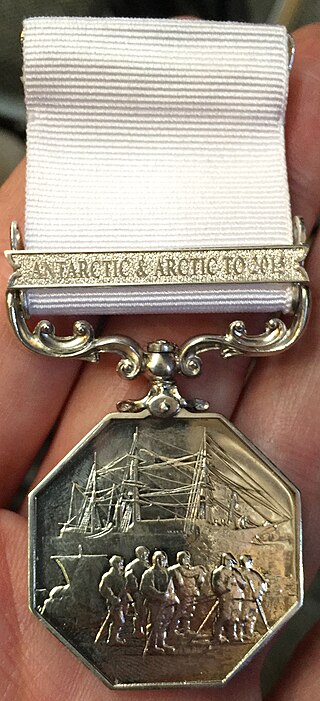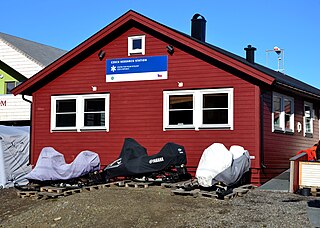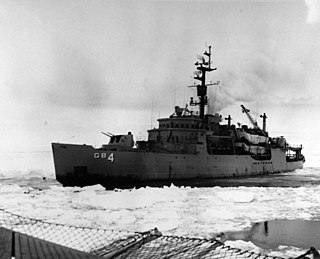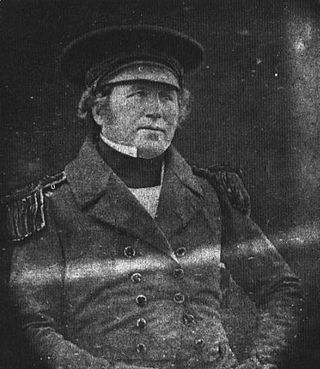
The Antarctic Treaty and related agreements, collectively known as the Antarctic Treaty System (ATS), regulate international relations with respect to Antarctica, Earth's only continent without a native human population. It was the first arms control agreement established during the Cold War, designating the continent as a scientific preserve, establishing freedom of scientific investigation, and banning military activity; for the purposes of the treaty system, Antarctica is defined as all the land and ice shelves south of 60°S latitude. Since September 2004, the Antarctic Treaty Secretariat, which implements the treaty system, is headquartered in Buenos Aires, Argentina.

In physical geography, tundra is a type of biome where tree growth is hindered by frigid temperatures and short growing seasons. The term is a Russian word adapted from Sámi languages. There are three regions and associated types of tundra: Arctic tundra, alpine tundra, and Antarctic tundra.

Albert Paddock Crary, was a pioneer polar geophysicist and glaciologist. He was the first person to have set foot on both the North and South Poles, having made it to the North Pole on May 3, 1952 and then to the South Pole on February 12, 1961, as the leader of a team of eight. The South Pole expedition set out from McMurdo Station on December 10, 1960, using three Snowcats with trailers. Crary was the seventh expedition leader to arrive at the South Pole by surface transportation. He was widely admired for his intellect, wit, skills and as a great administrator for polar research expeditions.

Events from the year 1941 in Canada.

Lincoln Ellsworth was a polar explorer from the United States and a major benefactor of the American Museum of Natural History.

The Polar Medal is a medal awarded by the Sovereign of the United Kingdom to individuals who have outstanding achievements in the field of polar research, and particularly for those who have worked over extended periods in harsh climates. It was instituted in 1857 as the Arctic Medal, and renamed the Polar Medal in 1904.

Research stations are facilities where scientific investigation, collection, analysis and experimentation occurs. A research station is a facility that is built for the purpose of conducting scientific research. There are also many types of research stations including: biological field stations, space stations etc. Research station sites might include remote areas of the world, oceans, as well as outer space, such as the International Space Station. Biological research stations developed during a time of European colonization and imperialism where naturalists were employed to conduct observations on fauna and flora. Today, the discipline is represented by a number of organizations which span across multiple continents. Some examples include: the Organization of Biological Field Stations and the Organization for Tropical Studies.

USS Glacier (AGB-4) was a U.S. Navy, then U.S. Coast Guard icebreaker which served in the first through fifteenth Operation Deep Freeze expeditions. Glacier was the first icebreaker to make her way through the frozen Bellingshausen Sea, and most of the topography in the area is named for her crew members. When built, Glacier had the largest capacity single armature DC motors ever installed on a ship. Glacier was capable of breaking ice up to 20 feet (6.1 m) thick, and of continuous breaking of 4-foot (1.2 m) thick ice at 3 knots.

Francis Rawdon Moira Crozier was an Irish officer of the Royal Navy and polar explorer who participated in six expeditions to the Arctic and Antarctic. In May 1845, he was second-in-command to Sir John Franklin and captain of HMS Terror during the Franklin expedition to discover the Northwest Passage, which ended with the loss of all 129 crewmen in mysterious circumstances.

Multiple governments have set up permanent research stations in Antarctica and these bases are widely distributed. Unlike the drifting ice stations set up in the Arctic, the current research stations of the Antarctic are constructed either on rocks or on ice that are fixed in place.
The Norwegian–British–Swedish Antarctic Expedition (1949–1952) was the first Antarctica expedition involving an international team of scientists. The team members came from Norway, Sweden and the British Commonwealth of Nations.
Allied Shipbuilders Ltd is a privately held shipbuilding and ship repairing company established in Canada in 1948.
The British Antarctic Survey (BAS) is the United Kingdom's national polar research institute. It has a dual purpose, to conduct polar science, enabling better understanding of global issues, and to provide an active presence in the Antarctic on behalf of the UK. It is part of the Natural Environment Research Council (NERC). With over 400 staff, BAS takes an active role in Antarctic affairs, operating five research stations, one ship and five aircraft in both polar regions, as well as addressing key global and regional issues. This involves joint research projects with over 40 UK universities and more than 120 national and international collaborations.

Sir James Clark Ross was a British Royal Navy officer and polar explorer known for his explorations of the Arctic, participating in two expeditions led by his uncle John Ross, and four led by William Edward Parry, and, in particular, for his own Antarctic expedition from 1839 to 1843.

The Heroic Age of Antarctic Exploration was an era in the exploration of the continent of Antarctica which began at the end of the 19th century, and ended after the First World War; the Shackleton–Rowett Expedition of 1921–1922 is often cited by historians as the dividing line between the "Heroic" and "Mechanical" ages.

Antarctica is Earth's southernmost and least-populated continent. Situated almost entirely south of the Antarctic Circle and surrounded by the Southern Ocean, it contains the geographic South Pole. Antarctica is the fifth-largest continent, being about 40% larger than Europe, and has an area of 14,200,000 km2 (5,500,000 sq mi). Most of Antarctica is covered by the Antarctic ice sheet, with an average thickness of 1.9 km (1.2 mi).
Students on Ice Foundation is a Canadian charitable organisation that leads educational expeditions to the Arctic and Antarctic for international high school and university students. Its mandate is to provide youth, educators and scientists from around the world with learning and teaching opportunities in the polar regions, with the goal of fostering an understanding of, and commitment to building a more sustainable future.

The Ross expedition was a voyage of scientific exploration of the Antarctic in 1839 to 1843, led by James Clark Ross, with two unusually strong warships, HMS Erebus and HMS Terror. It explored what is now called the Ross Sea and discovered the Ross Ice Shelf. On the expedition, Ross discovered the Transantarctic Mountains and the volcanoes Mount Erebus and Mount Terror, named after each ship. The young botanist Joseph Dalton Hooker made his name on the expedition.

There may have been women in Antarctica and exploring the regions around Antarctica for many centuries. The most celebrated "first" for women was in 1935 when Caroline Mikkelsen became the first woman to set foot on one of Antarctica's islands. Early male explorers, such as Richard Byrd, named areas of Antarctica after wives and female heads of state. As Antarctica moved from a place of exploration and conquest to a scientific frontier, women worked to be included in the sciences. The first countries to have female scientists working in Antarctica were the Soviet Union, South Africa and Argentina.

Homeward Bound is an organisation based in Australia that holds leadership programs for women in science. Founded in 2015, the leadership program aims to increase the representation of women in leadership roles in science fields.
















